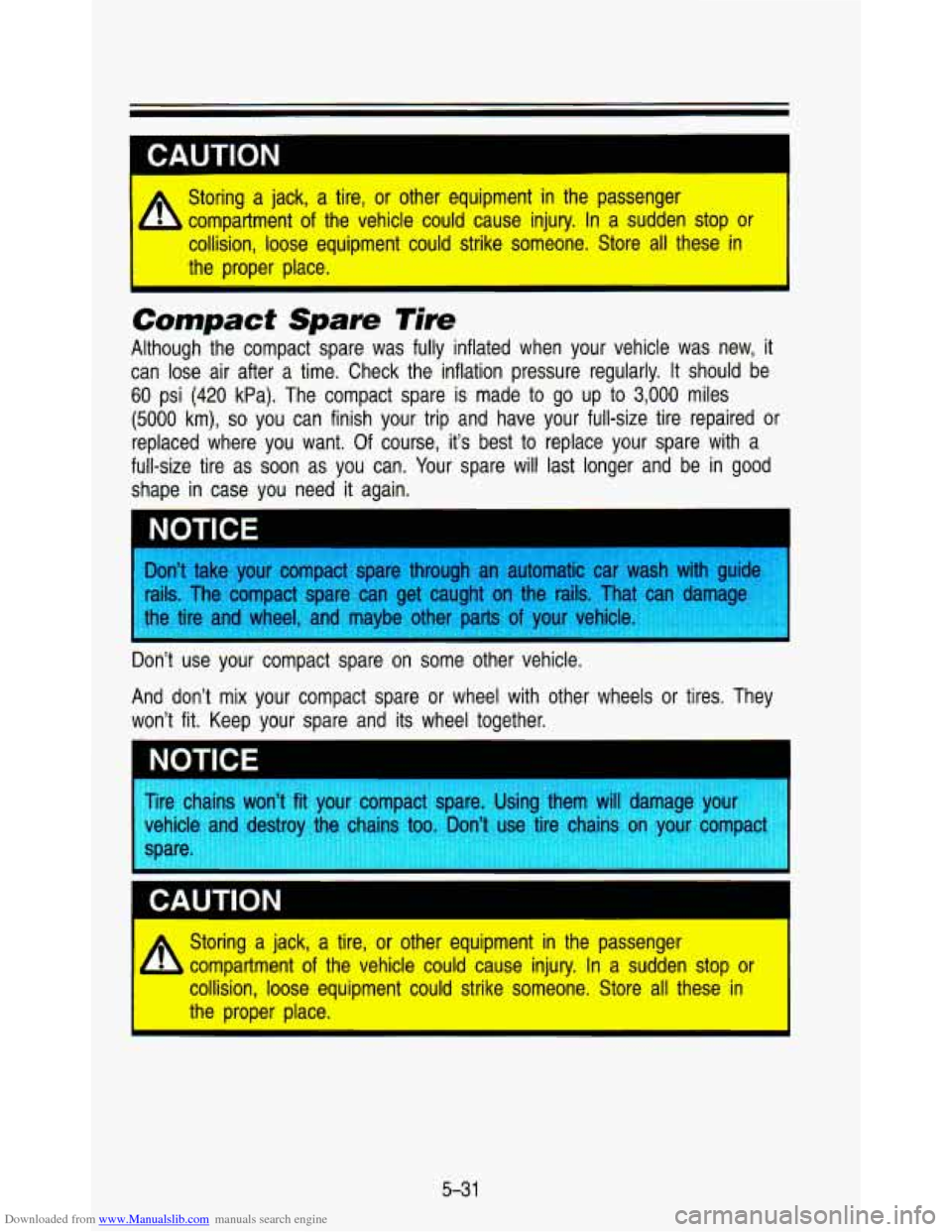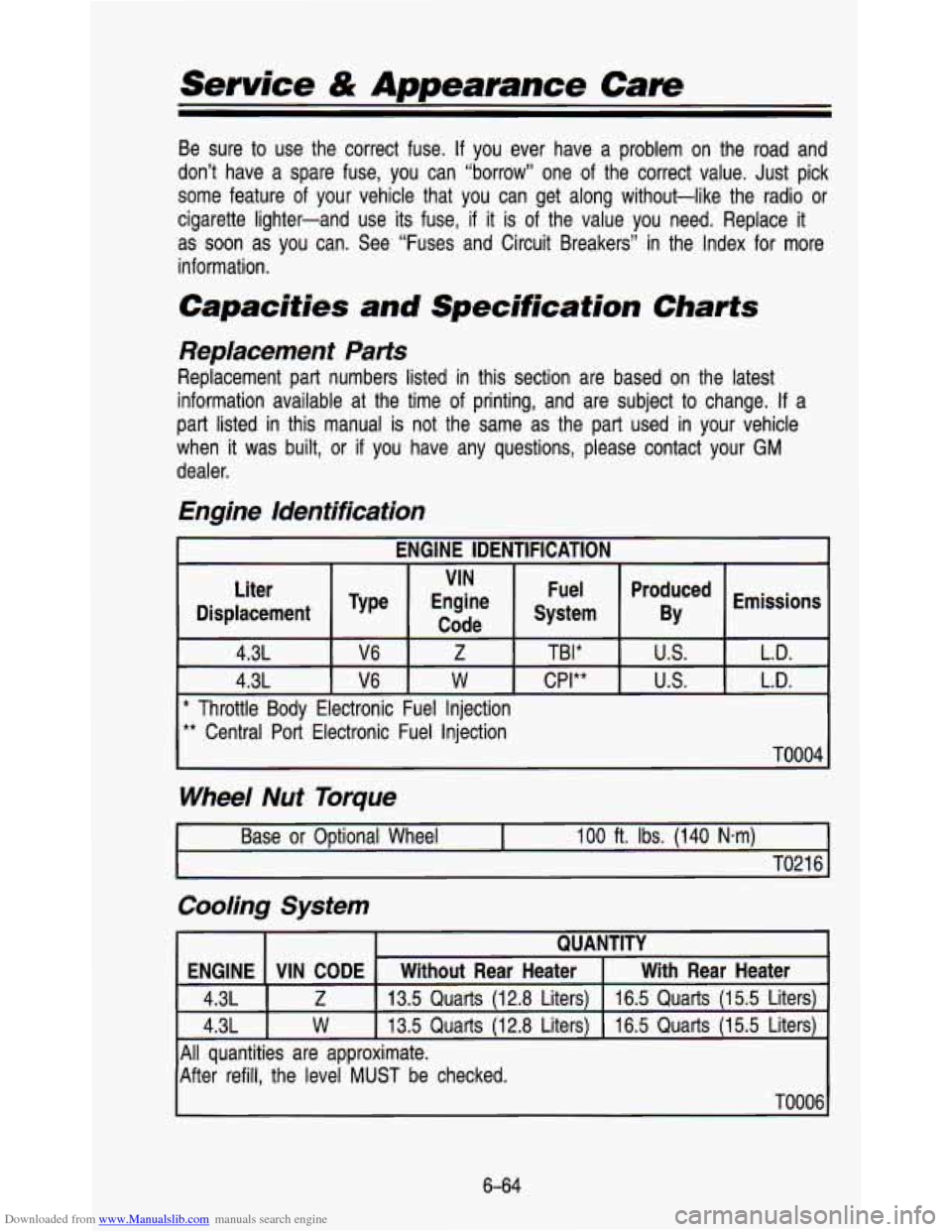Page 223 of 345
Downloaded from www.Manualslib.com manuals search engine I' i .. ,. ..
K3524
Remove the wheel blocks and jack by turning the wing nut counterclock\
wise.
Remove the wing nut and washer then
pull the wheel blocks and jack off the
bolt.
To remove the ratchet and extension by turning the wing nut
counterclockwise. Remove the wing nut and retainer and take out\
the ratchet and extension.
Spare Tire
K3526
Your spare tire is stored underneath your vehicle. You will use the ratchet
and extension to lower the spare tire.
5-1 9
Page 227 of 345
Downloaded from www.Manualslib.com manuals search engine ...._I pw: .. . . . , , . . .
.. , , . . . . . . .
.. . . .. .. . .. . . . . . . . . . .. . .. . .. ,. . . . . . . . . .. ..
. . . .. .. . . . .. .. .. . .
PO456
You have two wheel blocks stored with your jack. Place blocks at the front
and rear
of the tire farthest away from the one being changed. That would
be the tire
on the other side of the vehicle, at the opposite end.
Put your spare tire near the flat tire. Remove the wheel trim.
I ,, '-..
--.-
If there is a wheel cover, remove it by using the flat end of the extension.
Pry along the edge of the wheel cover until it comes off. Be careful; the rim
edges may be sharp. Don't
try to remove it with your bare hands.
5-23
Page 230 of 345
Downloaded from www.Manualslib.com manuals search engine Problems on the Road
.. I ." -_ . - I 4.. I
PO463
Raise the vehicle by rotating the ratchet clockwise. Make sure the UP
marking faces you. Raise the vehicle far enough off the ground so there is
enough room for the spare tire to fit.
PO457
Remove all the wheel nuts and take off the flat tire.
5-26
Page 231 of 345
Downloaded from www.Manualslib.com manuals search engine K3543
A
Rust or dirt on the wheel, or on the parts to which it is fastened,
can make the wheel nuts become loose after a time. The wheel \
could fall
off and cause an accident. When you change a wheel,
remove any rust or dirt from the places where the wheel attac\
hes
to
to do this; but be sure to use a scraper or wire brush later, if you
I the vehicle. In an emergency, you can use a cloth or a paper towel
~ need to, to get all the rust or dirt off.
Remove any rust or dirt from the wheel bolts, mounting surfaces. or spare
wheel. Place the spare on the wheel mounting surface.
IL.
A
Never use oil or grease on studs or nuts. If you do, the nuts might
come loose. Your wheel could fall
off, causing a serious accident.
r
CAb I'ION
5-27
Page 233 of 345
Downloaded from www.Manualslib.com manuals search engine PO465
Tighten the wheel nuts firmly in a criss-cross sequence as shown. Rotate the
ratchet clockwise with the
UP marking facing you.
* Incorrect wheel nuts or improperly tightened wheel nuts can cause
’, the wheel to become loose and even come off. This could lead to
an accident. Be sure to use the correct wheel nuts.
If you have to
replace them, be sure to get the right kind.
I
Stop somewhere as soon as you can and have the wheel nuts
tightened with a torque wrench to the proper torque.
I
For proper wheel nut torque, see “Wheel Nut Torque” in t\
he Index.
Don’t try to put a wheel cover on your compact spare tire. It won’t fit\
. Store
the wheel cover in the trunk until you have the
flat tire repaired or replaced.
I covers won’t fit on your cc I try to put a 1
cover or the Spi
Remove the wheel blocks.
5-29
Page 235 of 345

Downloaded from www.Manualslib.com manuals search engine I
Storing a jack, a tire, or other equipment in the passenger
b compartment of the vehicle could cause injury. In a sudden stop or
collision, loose equipment could strike someone. Store all these\
in
I the proper place.
Compact Spare Tire
Although the compact spare was fully inflated when your vehicle\
was new, it
can lose air after a time. Check the inflation pressure regula\
rly. It should be
60 psi (420 kPa). The compact spare is made to go up to 3,000 miles
(5000 km), so you can finish your trip and have your full-size tire repaired\
or
replaced where you want. Of course, it’s best
to replace your spare with a
full-size tire as soon as you can. Your spare
will last longer and be in good
shape in case you need
it again.
Don’t use your compact spare on some other vehicle.
And don’t mix your compact spare or wheel with other wheels\
or tires. They
won’t fit. Keep your spare and its wheel together.
Tire chains won’t fit your compact spare. Using them will d\
amage your vehicle and destro) “re chc”? too. Don’t use
ti- chair - 3n your compacl
spare.
A
Storing a jack, a tire, or other equipment in the passenger
compartment
of the vehicle could cause injury. In a sudden stop or
collision, loose equipment could strike someone. Store all these\
in
the proper place.
I
5-3 1
Page 285 of 345

Downloaded from www.Manualslib.com manuals search engine If you ever replace your tires with those not having a TPC Spec \
number,
make sure they are the same size, load range, speed rating an\
d construction
type (bias, bias-belted
or radial) as your original tires.
A
Mixing tires could cause you to lose control while driving. If you mix
tires
of different sizes or types (like radial and bias-belted tires) the
vehicle may not handle properly, and you could have a crash. Be
sure
to use the same size and type tires on all wheels. I
It’s all right to drive with your compact spare, though. It was developed for
limited use on your vehicle.
Uniform Tire Quality Grading
The following information relates to the system developed by the United
States National Highway Traffic Safety Administration which grade\
s tires by
treadwear, traction and temperature performance. (This applies o\
nly
to
vehicles sold in the United States.)
Treadwear
The treadwear grade is a comparative rating based on the wear \
rate of the
tire when tested under controlled conditions on a specified governmen\
t test
course.
For example, a tire graded 150 would wear one and a half (142)
times as well on the government course as a tire graded 100. The relative
performance of tires depends upon the actual conditions
of their use,
however, and may depart significantly from the norm due to var\
iations in
driving habits, service practices and differences in road charac\
teristics and
climate.
Traction-A, B, C
The traction grades, from highest to lowest are: A, B, and C. They represent
the tire’s ability
to stop on wet pavement as measured under controlled
conditions on specified government test surfaces of asphalt and \
concrete.
A
tire marked C may have poor traction performance.
Warning: The traction grade assigned
to this tire is based on braking
(straight-ahead) traction tests and does not include cornering \
(turning) traction.
Temperatur+A, B, C
The temperature grades are A (the highest), B, and C, representing the tire’s
resistance
to the generation of heat and its ability to dissipate heat when
tested under controlled conditions on a specified indoor laborat\
ory test wheel. Sustained high temperature can cause the material of the tire
to degenerate
and reduce tire life, and excessive temperature can lead
to sudden tire
6-49
Page 300 of 345

Downloaded from www.Manualslib.com manuals search engine Service & Appearance Cam
Be sure to use the correct fuse. If you ever have a problem on the road and
don’t have a spare fuse, you can “borrow” one of the correct value. Just pick
some feature of your
cigarette lighter-and
as soon
as you can.
information.
Capacities
vehicle that you can get along without-like the radio or
use its fuse,
if it is of the value you need.. Replace it
See “Fuses and Circuit Breakers” in the Index for more
and Specification Charts
Replacement Parfs
Replacement part numbers listed in this section are based on the latest
information available at the time of printing, and are subject to change.
If a
part listed in this manual is not the same as the part used in your vehicle
when
it was built, or if you have any questions, please contact your GM
dealer.
Engine Identification
IGINE IDENTIFICATION
Liter VIN
Fuel
Code
BY Displacement System
Engine
Type
Produced Emissions
4.3L
L.D. U.S. CPI** W V6 4.3L L.D.
us. TBI* Z V6
* Throttle Body Electronic Fuel Injection
** Central Port Electronic Fuel Injection
~0004
Wheel Nut Torque
I Base or Optional Wheel I 100 ft. Ibs. (140
N-m) I
I TO21 6 I
Cooling System
ENGINE With Rear Heater
Without Rear Heater
VIN CODE
QUANTITY
4.3L I Z
16.5 Quarts (1 5.5 Liters)
13.5 Quarts (1 2.8 Liters)
4.3L I w
16.5 Quarts (I 5.5 Liters) 13.5 Quarts (1 2.8 Liters)
All quantities are approximate.
After refill, the level
MUST be checked.
TO006
6-64